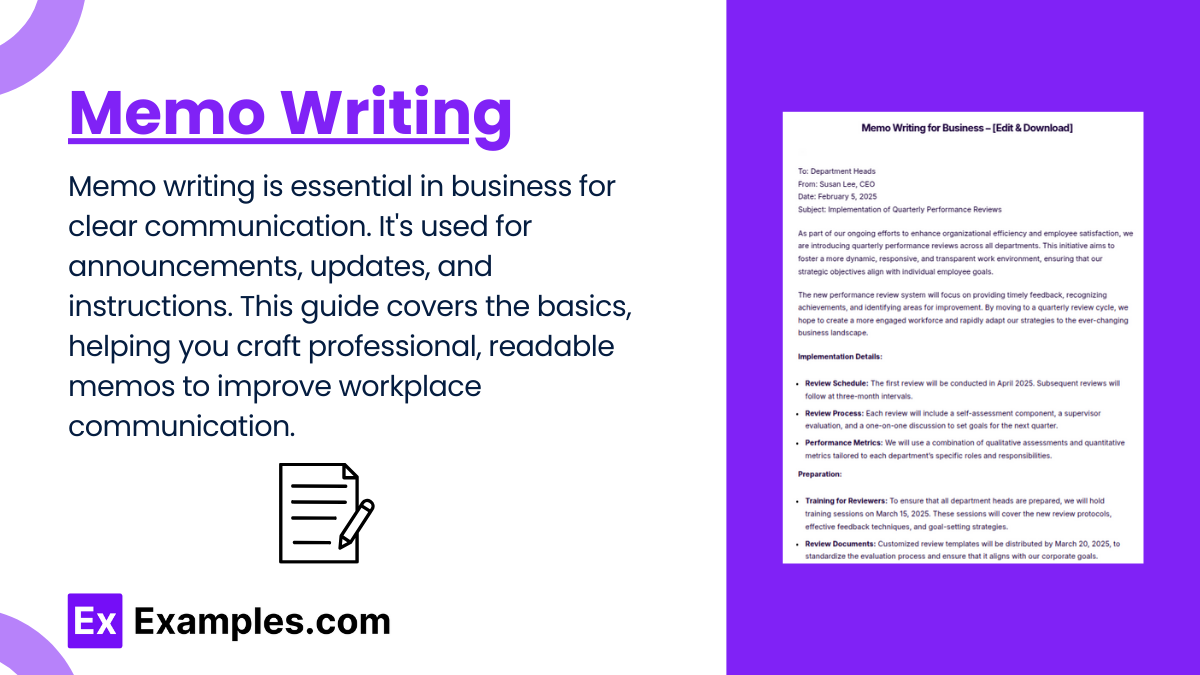15+ Memo Writing Examples to Download
Memo writing is a vital skill in the business world, serving as a straightforward and effective way to communicate important information within an organization. Whether you’re announcing a policy change, giving updates, or instructing your team about an upcoming project, memos help you convey your message clearly and concisely. This article will guide you through the basics of memo writing, from understanding its purpose to crafting a message that is easy to read and professional. By mastering the art of memo writing and using memo templates, you’ll enhance your ability to communicate within your workplace efficiently and effectively.
What is Memo Writing?

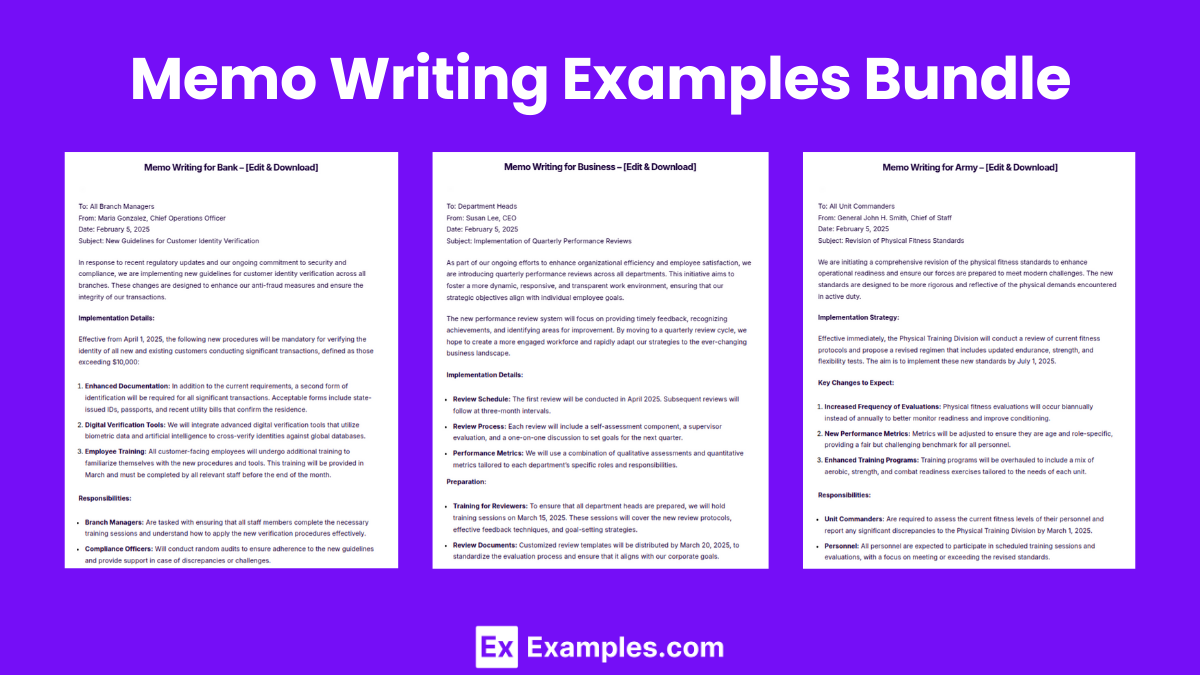
Memo Writing Format
Heading
The heading of a memo provides essential information and should include who the memo is for, who it’s from, the date it was written, and a clear subject line that reflects the memo’s purpose.
Opening
In the opening section, briefly state the purpose of the memo. This part should immediately inform the reader about the reason for the memo and what it aims to communicate.
Body
The body of the memo is where you provide the detailed information. This should be clear and concise, organized logically for easy reading. Depending on the content, this section can consist of a few sentences or several paragraphs.
Closing
The closing section wraps up the memo. It may include a call to action, a summary of the points made, or a polite closing remark. If any action is required from the reader, this is where you would mention it.
Attachments
If the memo refers to other documents or materials, list them under the attachments section. This lets the reader know that additional information is available and where it can be found.
Memo Writing Example
Memo Writing Examples
Memo Writing for Business
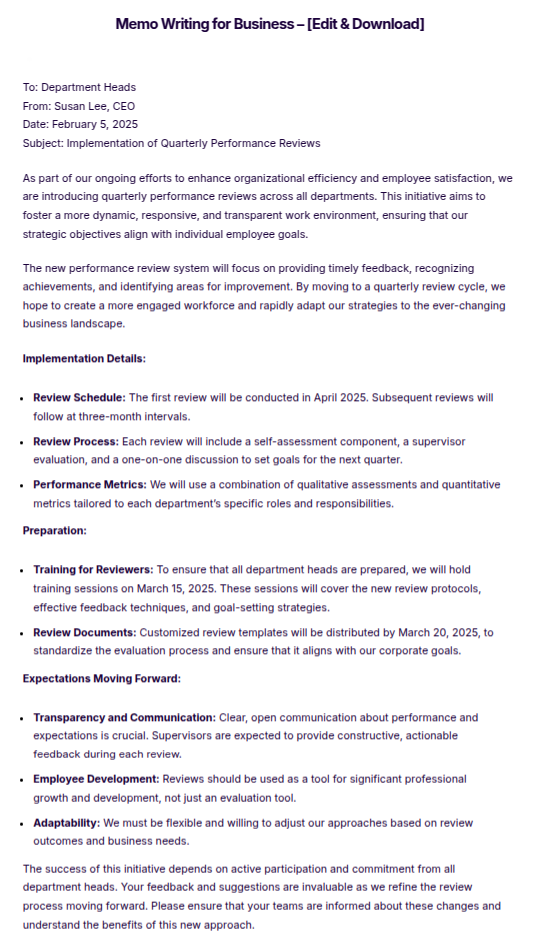
Memo Writing for Army

Memo Writing for Bank
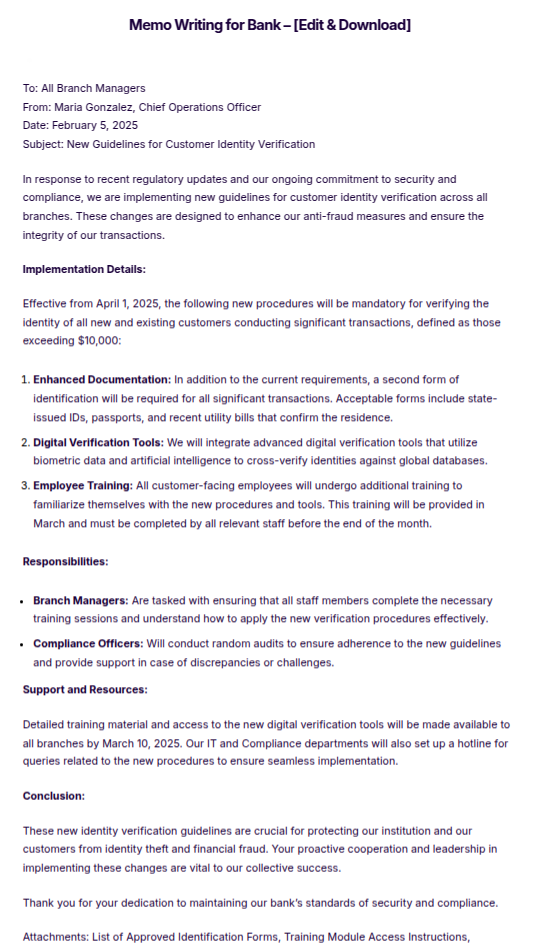
More Examples on Memo Writing
- Memo Writing for Project Submission
- Memo Writing for College Students
- Memo Writing for Work
- Legal Memo Writing
- Student Memo
- Employee Memo
- Holiday Memo
- Meeting Memo
- Training Memo
- Office Memo
Professional Memo Template
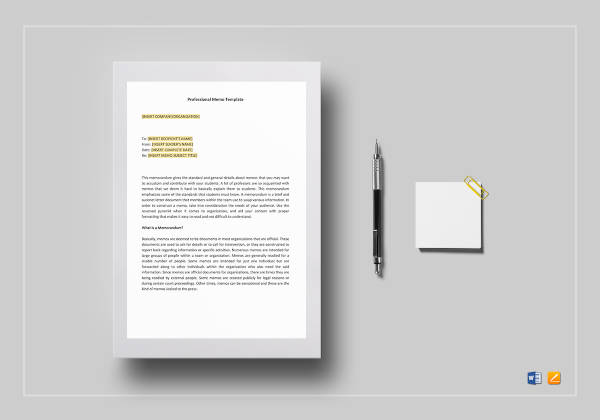
Memo Template
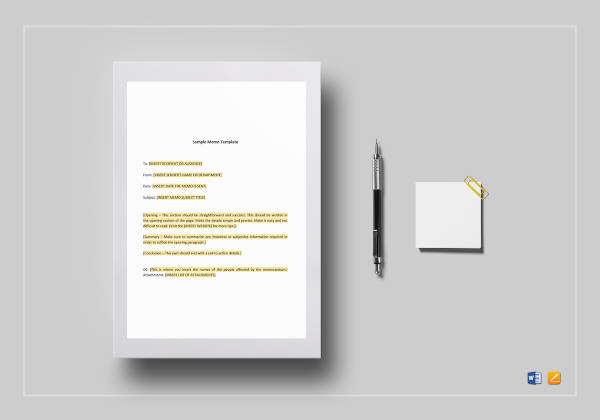
General Memo Writing Example
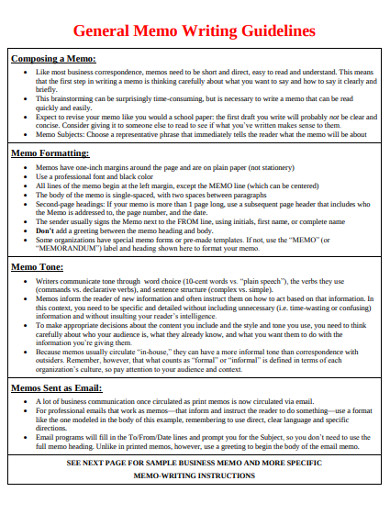
Sample Memo Writing
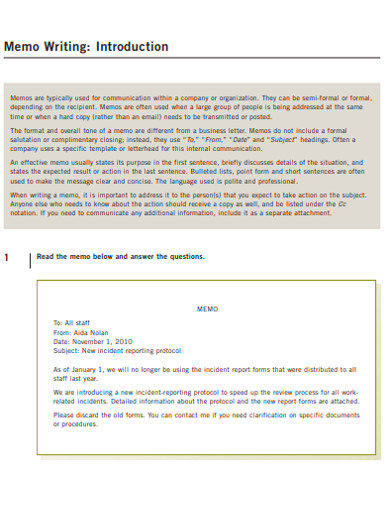
Types of Memos
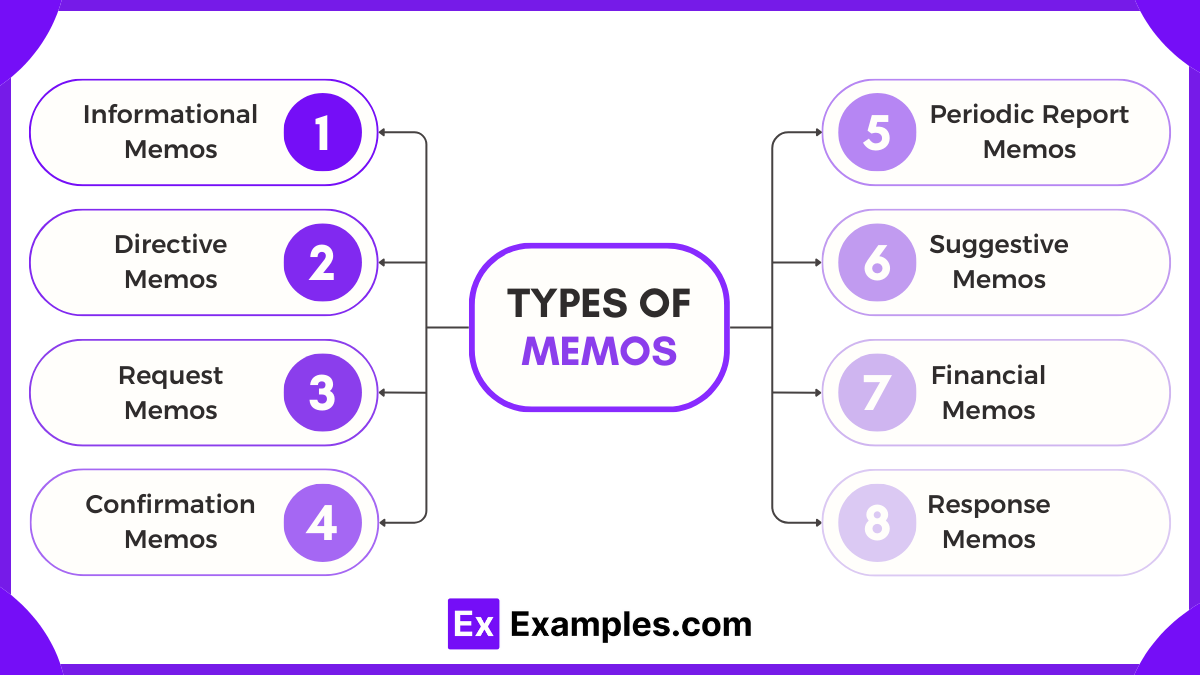
1. Informational Memos
Informational memos are used to disseminate important information to employees or team members. These memos might announce new policies, provide updates on company business, or inform about upcoming meetings. The goal is to keep everyone in the loop and ensure that relevant information is communicated clearly and efficiently.
2. Directive Memos
Directive memos are written to give instructions or directions to staff. They are used to initiate action, direct an activity, or give orders within an organization. These memos need to be clear and direct to avoid any confusion about what is expected.
3. Request Memos
Request memos are used to ask for permission, information, support, or action from other departments or individuals. These memos must be polite yet clear, outlining what is being requested and why it is necessary.
4. Confirmation Memos
Confirmation memos serve as a follow-up to meetings, agreements, or discussions. They document what was decided or discussed, confirming the outcomes for all parties involved. This type of memo helps ensure all participants understand their obligations or the consensus reached.
5. Periodic Report Memos
Periodic report memos are used to update superiors or teams about ongoing projects or tasks. They are typically scheduled (daily, weekly, monthly) and focus on progress, issues, and next steps. These memos are crucial for keeping projects on track and stakeholders informed.
6. Suggestive Memos
Suggestive memos propose changes or ideas that might benefit the organization. These memos are often used to suggest improvements, innovations, or solutions to existing problems. They should be persuasive, well-reasoned, and backed by data or research when possible.
7. Financial Memos
Financial memos are specific to financial issues within an organization. They might discuss budget adjustments, financial strategies, or fiscal reports. These memos must be detailed and precise, providing clear data and explanations to support financial decisions.
8. Response Memos
Response memos reply to inquiries or issues raised by other memos or communications. They address concerns, answer questions, and provide clarity on previous communications. Response memos should be timely to effectively manage communications within an organization.
How is a Memo Different from an Email?
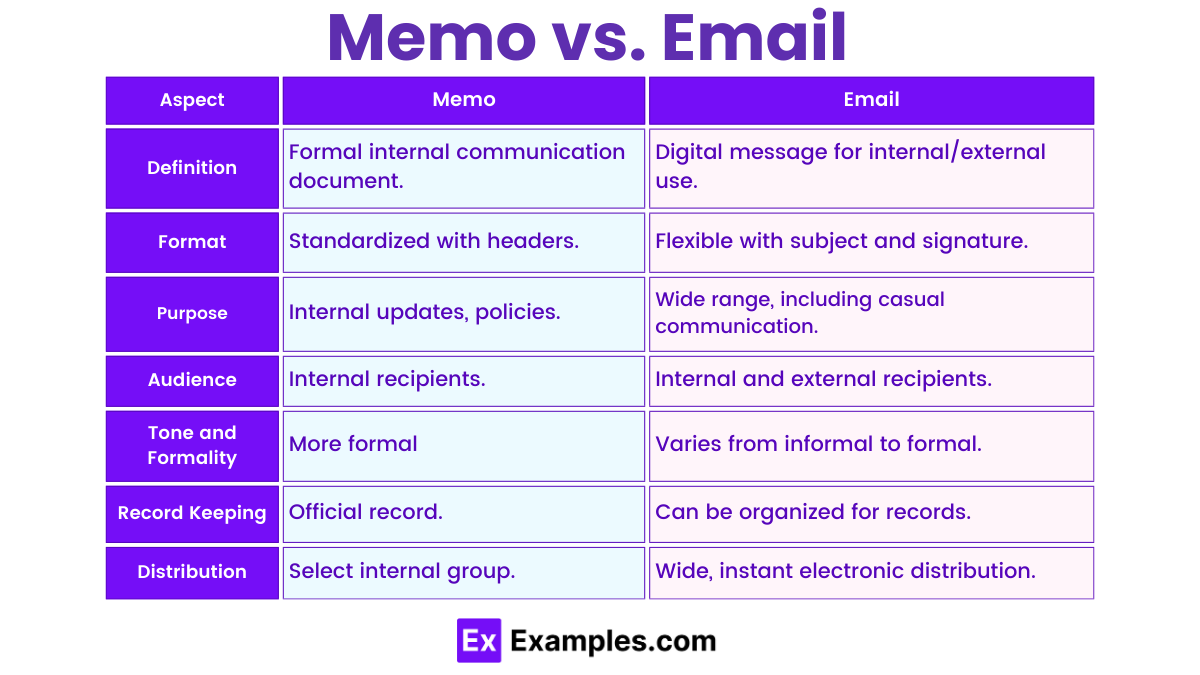
While both memos and emails serve as tools for communication, they differ in several key aspects, from their format and usage to their audience and formalities. Understanding these differences is crucial for choosing the most appropriate medium for your message. Here’s a breakdown of how a memo differs from an email:
1. Format and Structure
- Memo: Typically follows a standard format that includes a header (with sections for to, from, date, and subject), an introduction, a body, and a conclusion or call to action. Memos are usually more structured and may follow a specific template within an organization.
- Email: More flexible in format, emails can range from informal to formal, depending on the sender, recipient, and purpose. They often start with a greeting, followed by the body of the message, and end with a closing and signature.
2. Purpose and Use
- Memo: Primarily used for internal communication within an organization. Memos are ideal for conveying policies, procedures, official announcements, and other information that requires formal documentation.
- Email: Can be used for both internal and external communication. Emails are versatile and can be used for a wide range of purposes, including informal communication, formal requests, marketing, and more.
3. Audience
- Memo: Generally intended for a specific audience within an organization, such as employees, departments, or teams. The audience of a memo is often predefined and limited to those directly involved or affected by its content.
- Email: Can be sent to anyone with an email address, making it suitable for both internal and external communication. Emails can easily be forwarded to additional recipients, expanding their audience beyond the original recipients.
4. Tone and Formality
- Memo: Often more formal than emails, reflecting the structured nature of the document and its use within organizational communication.
- Email: The tone can vary widely from casual to highly formal, depending on the sender’s relationship with the recipients and the email’s purpose.
5. Record Keeping
- Memo: Serves as an official record of communication within an organization. Memos are often filed and archived for future reference.
- Email: Can also be archived and serve as a record of communication, but the ease of deletion and the volume of emails can make long-term record keeping and retrieval more challenging.
6. Distribution
- Memo: Traditionally, memos were distributed in print form, but they can also be distributed electronically. The distribution of memos is usually controlled and targeted.
- Email: Distributed electronically and instantly to one or multiple recipients, making it a faster way to reach a broad audience.
How to Write a Memo
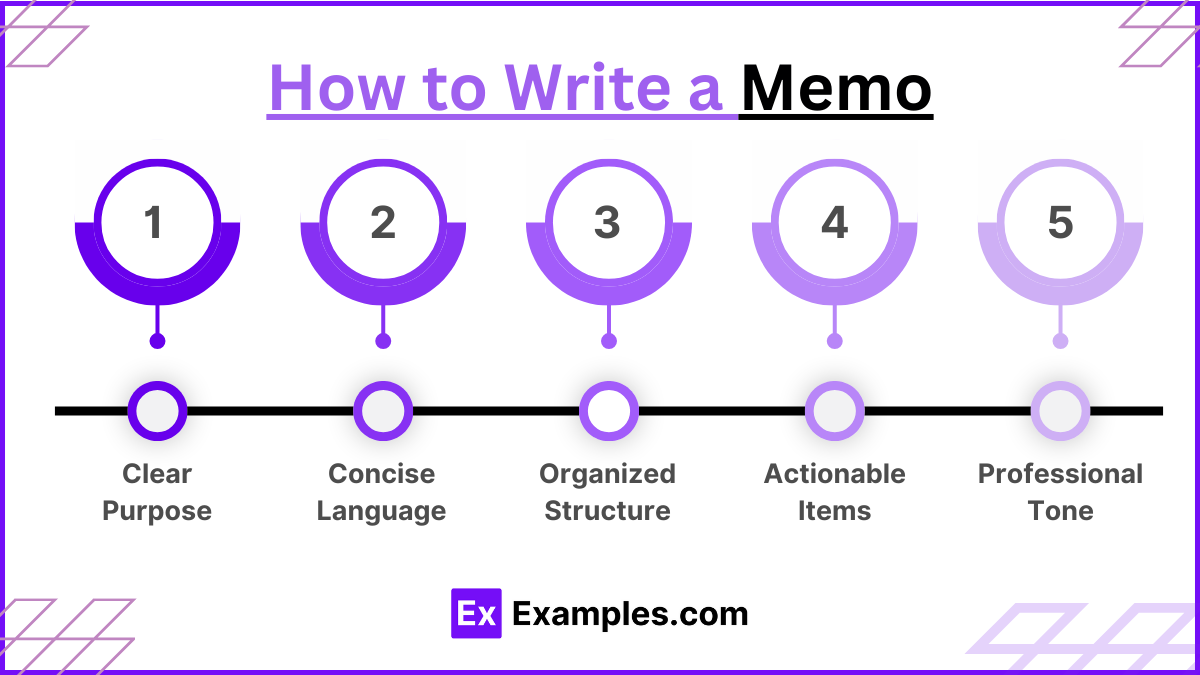
- Clear Purpose: Start by stating the purpose of the memo. Be direct and concise in explaining the reason for the memo at the very beginning to ensure the reader understands the importance of the message.
- Concise Language: Use simple and straightforward language. Avoid jargon or complex vocabulary that could confuse the reader. Keep sentences short and to the point to enhance clarity and readability.
- Organized Structure: Organize the content logically. Start with the most critical information, followed by supporting details. Use headings and bullet points to break up the text and make it easier to scan.
- Actionable Items: If the memo is intended to prompt action, clearly state what is expected of the reader. Specify any deadlines and whom to contact for further information.
- Professional Tone: Maintain a professional tone throughout the memo. Even if the memo is internal, it should still reflect respect and professionalism towards all readers.
Tips for Writing Memos
- Identify Your Audience: Understand who will be reading the memo and tailor the language and detail accordingly. This ensures the information is relevant and presented in a way that resonates with the audience.
- Be Brief and Direct: Keep your memo concise. Stick to the point and avoid unnecessary details. Memos are meant to be quick reads that communicate essential information efficiently.
- Use a Standard Format: Follow a standard memo format to ensure consistency and professionalism. This typically includes sections like the heading (with To, From, Date, and Subject lines), introduction, body, and conclusion.
- Highlight Key Points: Emphasize the main points using bullet points, bold text, or underlining. This helps the reader quickly grasp the most important information.
- Proofread: Always proofread your memo before sending it out. Check for grammatical errors, typos, and ensure that the content is clear and makes sense. This step is crucial for maintaining professionalism and clarity in communication.
Guidelines for Memo Writing
- Start with a Clear Header: Include “To,” “From,” “Date,” and “Subject” fields to clarify the memo’s recipients, author, date, and purpose.
- Open with the Main Point: Begin the body with the primary purpose or issue, providing immediate context for the reader.
- Structure the Content Clearly: Organize the information with headings, subheadings, and bullet points for easy navigation and comprehension.
- Keep It Concise: Limit the content to essential information, using straightforward sentences to communicate effectively.
- Use a Professional Tone: Maintain formality and respect, avoiding casual language to preserve the memo’s professional integrity.
- Specify Action Required: Clearly state any actions needed, who is responsible, and the deadlines to ensure follow-through.
- Close with a Summary or Conclusion: Recap the key points or conclude with a reinforcing statement to solidify the memo’s message.
- Proofread: Review the memo for any errors or unclear wording to enhance clarity and professionalism before sending.
FAQs
What is the purpose of a memo?
The purpose of a memo is to inform, request information, or call to action within a professional setting.
Who are the typical recipients of a memo?
Memos are typically sent to colleagues and superiors within an organization to share information relevant to their operations.
How long should a memo be?
A memo should be as brief as possible while including all vital information, typically no more than a page.
Can a memo be sent electronically?
Yes, memos can be sent electronically via email or other digital communication tools, which is common in most modern workplaces.
What tone should be used in a memo?
The tone of a memo should be professional and straightforward, focusing on clarity and brevity to ensure effective communication.


